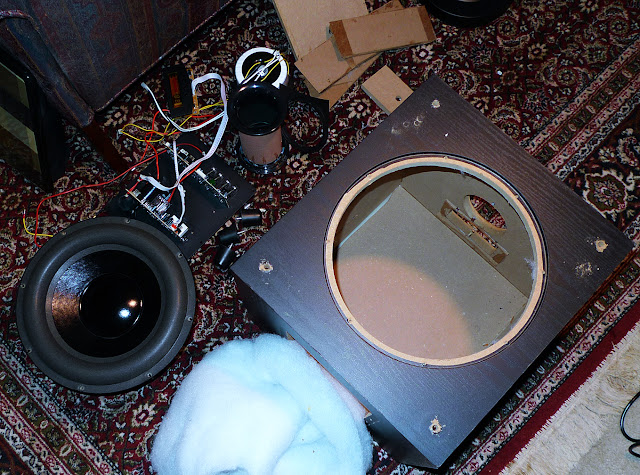January 25, 2018
#226
Gentle reader,
The word "subwoofer" is often, very often, misused or misapplied. The prefix sub means below, beneath, or under. Also short for submarine which has two meanings. Bass music and sounds are by definition, DEEP. They say humans can hear from 20 Hertz to 20,000 Hertz. Men tend to lose the high notes and sounds as they age.
A true subwoofer should then provide the BASS notes and sounds, ideally all the way to 20 Hertz. However, there is no musical instrument that can reach that mow. There are sounds, explosions and such that can be that deep. Also music harmonics can go that low. Any deeper than that is felt rather than heard. To go deep requires moving a LOT of air. A small driver (woofer) is physically incapable of moving enough air at the lowest frequencies. So any speaker that has a driver smaller than ten inches is not a subwoofer.
Years ago, I purchased this A-Neutronics subwoofer that has a 12 inch driver that fires downward. Note, the wires seen it the bass reflex port below are usually hidden. But these are autopsy photos. The port takes the sound waves when the driver moves rearward and lets those notes enter the room. Hopefully at the exact instant the driver has moved forward again playing the same note. When playing Telarc's 1812 Overture by Eric Kunzel and the Cincinnati Pops Orchestra, which has the best cannon shots of any 1812 performance, the air from this port can be felt as it hits my legs.
The first thing I checked was the fuses inside the plate amplifier below. Both were good, there is a third one in a compartment above the power cable which was also good. The buttons and LEDs above the port (photo above) show the volume level digitally and the volume levels with LEDs to the right of the numbers. ALL lights come on, but not one bit of sound, the buttons work, making the numbers go up and down. No sound.
This is the amplifier plate on the back. The silver label was shining from the flash, so I "painted" it grey with Photoshop. Below shows the healthy 12" driver. Just look at that robust surround!
Note: I always had a piece of plywood or solid wood shelf underneath this when used on carpeting. Otherwise, much of the sound is absorbed by the carpet and padding.
This is what is above the driver. The box holds the plate amplifier. The white cylinder is a Toriodal power transformer. Unlike traditional square black transformers, they are supposedly superior. I do not know why.
The deceased fully dissected. I even dissected the little boxes.
There is a relay on the bottom circuit board (see through to the right of the big black capacitor cylinder) that may be at fault. But I have no way to tell.
See the hole above and below? That is a vent to allow the air being moved by the voicecoil to enter and escape. The bump it is centered in allows the voicecoil to move further rearward. These are marks of a quality woofer.
I was about to donate the subwoofer and decided to test it first. I removed the driver (woofer) and found the wires had come off. They were a bit too short. So I soldered in some longer ones with new terminals. Still no sound.
I put the driver and port and the rest of the "guts" on eBay in separate auctions. The woofer is good, but I have no use for it.
Thanks for looking,
Scott
January 25, 2018













































